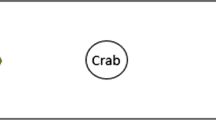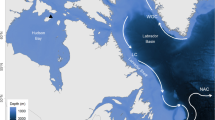Abstract
Despite rapidly growing interest in the effects of ocean acidification on marine animals, the ability of deep-sea animals to acclimate or adapt to reduced pH conditions has received little attention. Deep-sea species are generally thought to be less tolerant of environmental variation than shallow-living species because they inhabit relatively stable conditions for nearly all environmental parameters. To explore whether deep-sea hermit crabs (Pagurus tanneri) can acclimate to ocean acidification over several weeks, we compared behavioral “boldness,” measured as time taken to re-emerge from shells after a simulated predatory attack by a toy octopus, under ambient (pH ∼7.6) and expected future (pH ∼7.1) conditions. The boldness measure for crab behavioral responses did not differ between different pH treatments, suggesting that future deep-sea acidification would not influence anti-predatory behavior. However, we did not examine the effects of olfactory cues released by predators that may affect hermit crab behavior and could be influenced by changes in the ocean carbonate system driven by increasing CO2 levels.
Similar content being viewed by others
References
Barry JP, Lovera C, Okuda C, Nelson E, Pane EF (2008) A gas-controlled aquarium system for ocean acidification studies. In: OCEANS 2008 - MTS/IEEE Kobe Techno-Ocean, Kobe, Japan, 8–11 Apr 2008, pp 1–5
Bibby R, Cleall-Harding P, Rundle S, Widdicombe S, Spicer J (2007) Ocean acidification disrupts induced defences in the intertidal gastropod Littorina littorea. Biol Letters 3:699–701. doi:10.1098/rsbl.2007.0457
Briffa M, de la Haye K, Munday PL (2012) High CO2 and marine animal behaviour: potential mechanisms and ecological consequences. Mar Pollut Bull 64:1519–1528
Briffa M, Elwood R (2000) The power of shell rapping influences rates of eviction in hermit crabs. Behav Ecol 11:288–293. doi:10.1093/beheco/11.3.288
Briffa M, Haskell P, Wilding C (2008a) Behavioural colour change in the hermit crab Pagurus bernhardus: reduced crypticity when the threat of predation is high. Behaviour 145:915–929. doi:10.1163/156853908784089261
Briffa M, Rundle S, Fryer A (2008b) Comparing the strength of behavioural plasticity and consistency across situations: animal personalities in the hermit crab Pagurus bernhardus. P Roy Soc B-Biol Sci 275:1305–1311. doi:10.1098/rspb.2008.0025
Briffa M, Twyman C (2011) Do I stand out or blend in? Conspicuousness awareness and consistent behavioural differences in hermit crabs. Biol Letters 7:330–332. doi:10.1098/rsbl.2010.0761
Byrne R, McElligott S, Feely R, Millero F (1999) The role of pH(T) measurements in marine CO2-system characterizations. Deep-Sea Res Pt I 46:1985–1997. doi:10.1016/S0967-0637(99)00031-X
Clements JC, Hunt HL (2015) Marine animal behaviour in a high CO2 ocean. Mar Ecol-Prog Ser 536:259–279
Cripps IL, Munday PL, McCormick MI (2011) Ocean acidification affects prey detection by a predatory reef fish. PloS One 6:e22736. doi:10.1371/journal.pone.0022736
de la Haye K, Spicer J, Widdicombe S, Briffa M (2011) Reduced sea water pH disrupts resource assessment and decision making in the hermit crab Pagurus bernhardus. Anim Behav 82:495–501. doi:10.1016/j.anbehav.2011.05.030
de la Haye K, Spicer J, Widdicombe S, Briffa M (2012) Reduced pH sea water disrupts chemo-responsive behaviour in an intertidal crustacean. J Exp Mar Biol Ecol 412:134–140. doi:10.1016/j.jembe.2011.11.013
Devine BM, Munday PL, Jones GP (2012) Rising CO2 concentrations affect settlement behaviour of larval damselfishes. Coral Reefs 31:229–238
Dicke M, Grostal P (2001) Chemical detection of natural enemies by arthropods: an ecological perspective. Annu Rev Ecol Syst 32:1–23
Dickson AG (1990) Thermodynamics of the dissociation of boricacid in synthetic seawater from 273.15-K to 318.15-K. Deep-Sea Res 37:755–766
Dickson AG, Millero FJ (1987) A comparison of the equilibrium-constants for the dissociation of carbonic-acid in seawater media. Deep-Sea Res 34:1733–1743
Dixson D, Munday P, Jones G (2010) Ocean acidification disrupts the innate ability of fish to detect predator olfactory cues. Ecol Lett 13:68–75. doi:10.1111/j.1461-0248.2009.01400.x
Dodd LF, Grabowski JH, Piehler MF, Westfield I, Ries JB (2015) Ocean acidification impairs crab foraging behaviour. P Roy Soc B-Biol Sci 282(1810). doi:10.1098/rspb.2015.0333
Doney SC, Fabry VJ, Feely RA, Kleypas JA (2009) Ocean acidification: the other CO2 problem. Ann Rev Mar Sci 1:169–192
Fabry VJ, Seibel BA, Feely RA, Orr JC (2008) Impacts of ocean acidification on marine fauna and ecosystem processes. ICES J Mar Sci 65:414–432
Feely RA, Sabine CL, Hernandez-Ayon JM, Ianson D, Hales B (2008) Evidence for upwelling of corrosive “acidified” water onto the continental shelf. Science 320:1490–1492
Friederich G, Walz P, Burczynski M, Chavez F (2002) Inorganic carbon in the central California upwelling system during the 1997–1999 El Nino-La Nina event. Prog Oceanogr 54:185–203. doi:10.1016/S0079-6611(02)00049-6
Gattuso J-P, Brewer PG, Hoegh-Guldberg O, Kleypas JA, Pörtner H-O, Schmidt DN (2014) Cross-chapter box on ocean acidification. In: Climate Change 2014: Impacts, Adaptation, and Vulnerability. Part A: Global and Sectoral Aspects. Contribution of Working Group II to the Fifth Assessment Report of the Intergovernmental Panel on Climate Change, Cambridge University Press, Cambridge, United Kingdom and New York, NY, USA, pp 129–131
Hazlett B, Bach C (2010) Individuality in the predator defense behaviour of the crab Heterozius rotundifrons. Behaviour 147:587–597. doi:10.1163/000579510X12629536366329
Ilyina T, Zeebe RE (2012) Detection and projection of carbonate dissolution in the water column and deep-sea sediments due to ocean acidification. Geophys Res Lett 39:L06606. doi:10.1029/2012GL051272
Ilyina T, Zeebe RE, Brewer PG (2010) Future ocean increasingly transparent to low-frequency sound owing to carbon dioxide emissions. Nat Geosci 3:18–22
Kim T, Christy J, Dennenmoser S, Choe J (2009) The strength of a female mate preference increases with predation risk. P Roy Soc B-Biol Sci 276:775–780. doi:10.1098/rspb.2008.1070
Kim TW, Taylor J, Lovera C, Barry JP (2016) CO2-driven decrease in pH disrupts olfactory behaviour and increases individual variation in deep-sea hermit crabs. ICES J Mar Sci 73:613–619
Leduc AOHC, Munday PL, Brown GE, Ferrari MCO (2013) Effects of acidification on olfactory-mediated behaviour in freshwater and marine ecosystems: a synthesis. Philos T R Soc B 368:20120447. doi:10.1098/rstb.2012.0447
Lee JA, Kim TW (2016) Effects of potential future CO2 levels in seawater on emerging behaviour and respiration of Manila clams, Venerupis philippinarum. ICES J Mar Sci. doi:10.1093/icesjms/fsw124
Munday P, Dixson D, Donelson J, Jones G, Pratchett M, Devitsina G, Doving K (2009) Ocean acidification impairs olfactory discrimination and homing ability of a marine fish. P Natl Acad Sci USA 106:1848–1852. doi:10.1073/pnas.0809996106
Nilsson G, Dixson D, Domenici P, McCormick M, Sorensen C, Watson S, Munday P (2012) Near-future carbon dioxide levels alter fish behaviour by interfering with neurotransmitter function. Nat Clim Change 2:201–204. doi:10.1038/NCLIMATE1352
Pane EF, Barry JP (2007) Extracellular acid-base regulation during short-term hypercapnia is effective in a shallow-water crab, but ineffective in a deep-sea crab. Mar Ecol-Prog Ser 334:1–9
Pierrot D, Lewis E, Wallace DWR (2006) CO2sys dos Program Developed for CO2 System Calculations. Ornl/cdiac-105. Carbon Dioxide Information Analysis Center, Oak Ridge National Laboratory, U. S. Department of Energy, Oak Ridge
Taylor JR, Lovera C, Whaling PJ, Buck KR, Pane EF, Barry JP (2014) Physiological effects of environmental acidification in the deep-sea urchin Strongylocentrotus fragilis. Biogeosciences 11:1413–1423
Wood H, Spicer J, Widdicombe S (2008) Ocean acidification may increase calcification rates, but at a cost. P Roy Soc B-Biol Sci 275:1767–1773. doi:10.1098/rspb.2008.0343
Author information
Authors and Affiliations
Corresponding author
Rights and permissions
About this article
Cite this article
Kim, T.W., Barry, J.P. Boldness in a deep sea hermit crab to simulated tactile predator attacks is unaffected by ocean acidification. Ocean Sci. J. 51, 381–386 (2016). https://doi.org/10.1007/s12601-016-0034-8
Received:
Revised:
Accepted:
Published:
Issue Date:
DOI: https://doi.org/10.1007/s12601-016-0034-8




